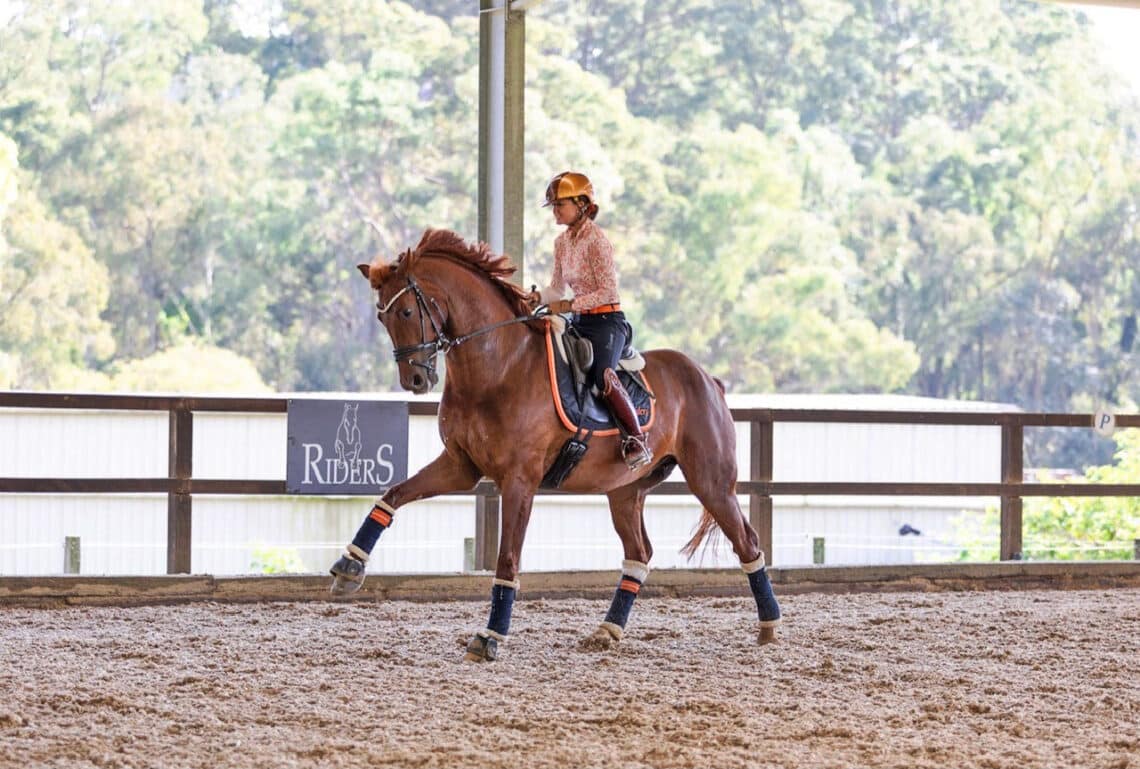
Time for High School: Mastering the Flying Change

Time for high school
In her five-part series, NICOLE TOUGH looks at dressage training through the levels – and now it’s off to high school to master the flying change.
Once our horse has a solid understanding and can perform the elementary tasks to a high degree of satisfaction and strength, we can turn our sights to medium training.
This is as big a jump as a student going from primary to high school for one big reason: the flying change. Nothing else is brand new for the horse at medium level. The extensions of the walk, trot and canter are developments of the medium walk/trot/canter required at elementary level, the turn on the haunches at walk become more centred in a half pirouette, and the half pass is the next phase of travers ridden across the school.
Nothing better prepares our horses for flying changes than the solid elementary training we gave them in their earlier years. It’s this training that ensures we can change their flexion and bend in the canter without them becoming muddled and losing confidence, and without interfering with their clear three-beat rhythm. They will have a round, balanced canter jump with a discernible moment of suspension and their hindleg towards the centre of gravity; and we can adjust the canter stride with good control of the straightness, suppleness and balance.
If your horse fails to comply with these prerequisites, they are not ready to start flying changes. That said, it’s vital to know that being ready to start flying change training is not a guarantee that it will be easy. If you or your horse are struggling, take heart in knowing you are not alone. The flying change needs to be a joint venture, a collaboration between rider and horse; and the timing of the aid is crucial to success.
The horse can only change their lead in the moment of suspension, and they need time to respond to the aid. Thus, the aid needs to be given just before the moment of suspension. This window of opportunity is on the last footfall of the canter phase when the old leading leg is on the ground, allowing the horse to change the leading leg in the actual moment of suspension.
Many riders make the mistake of giving the aid either in, or too close to the moment of suspension, which doesn’t give the horse time to act on the signal. The horse cannot organise themselves in time and end up running away or changing late behind.
To master the feel of the right timing, canter a circle and say ‘now’ out loud each time the leading leg is on the ground. And there are a few more helpful tips:
- Always attempt the flying change towards the horse’s better side. Most horses are crooked to the right, so starting right to left should help with success.
- Pick a place. My preference is a half 10 metre circle at R or S onto the centre line towards C, with the change to be attempted before G.
- Simulate the change from walk, practising your aids, and signalling the canter strike off on the ‘new’ side. In the above scenario, we would walk on the right rein, a half 10 metre circle at R onto the centre line and whilst holding our legs in right canter position, prepare the horse to pick up left lead in canter. Once we feel them accept this preparation, switch leg aids and canter left, turning left at C. Repeat this simulation with a good simple change, before attempting the flying change.
- Always practise the flying change in the same place. Only when the horse has understood the exercise should we attempt it in different places. We should also incorporate the same line/figure without a change to encourage the horse to wait.
- Always stop and praise your horse if they are successful in an attempt.
A few more tips for this difficult stage of training:
- In the first month, do not stress about clean changes. The first stage is just about the horse understanding they have to get from one canter lead to the other whilst cantering. After understanding is reached, it is vital the flying change is carried out in the one moment of suspension, not in two parts. This stage requires a coach or a spotter every time you attempt your changes, so they can tell you if it was clean or in two parts. If in two parts, immediately walk, return to the old lead and try again.
- Whilst anticipation is encouraged, it is imperative we teach them to wait. If they change ahead of the aid, return to walk and try again.
- Be happy with a clean change each way and don’t do more. Establishing the flying change successfully can take from 12 to 18 months.
- The horse must never feel afraid to make a mistake. Encourage them to try and if they make a mistake, rather than chastise them, we should go back a step and repeat. Patience is the key.
Make no mistake. This really is the start of high school, and progression beyond this stage is impossible without a clean, calm flying change to each side. Stay patient and stay true to your horse.
For more information on lessons or a clinic with Nicole, visit Nicole Tough Dressage.



